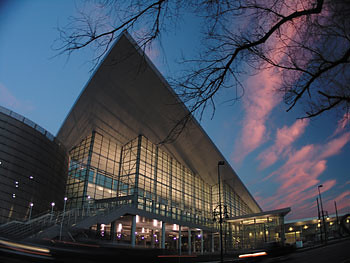









 Pulitzer Prize-winning author Michael Chabon strode onto the stage to give his keynote speech on Wednesday--jeans, black jacket, slight case of bed head, scruffy beard. Museums, he said, are to him a kind of imaginative space. He then spent the rest of his time on an eloquent essay/harangue about childhood: how the woods behind his house, though tame and urban, still held “unfathomable shadows” at night and how he freely ranged the “topography of childhood” on his bicycle.
Pulitzer Prize-winning author Michael Chabon strode onto the stage to give his keynote speech on Wednesday--jeans, black jacket, slight case of bed head, scruffy beard. Museums, he said, are to him a kind of imaginative space. He then spent the rest of his time on an eloquent essay/harangue about childhood: how the woods behind his house, though tame and urban, still held “unfathomable shadows” at night and how he freely ranged the “topography of childhood” on his bicycle.Forms of children’s entertainment—and parents—should not be “unctuous butlers of the imagination,” he contended. Kids need “a gap, a small, enchanted precinct of adult disapproval, the deep, furtive pleasure of annoying one’s father.” All sports are now organized, kids treat-or-treat in school gyms and letting one’s children play in the streets invites abductions. We need, he argued, a line between a child’s world and an adult’s.
The bus ride up into the foothills of the
The first thing we saw when we entered--well, not the first thing; the museum store is always the first thing--was a gray climbing wall, 50 feet high. A fake vertical cliff, basically, with handholds and footholds conveniently placed. Lines quickly formed. Now, I have a fear of heights, but I went over to the bunny-slope line anyway. And do you know I went up that faux mountain like Spider-Man? Cheers rang out from below, as they had anytime anyone made it.
The other treat: Jake Norton--who has successfully climbed

 Author Steven Berlin Johnson's seven-year-old nephew, Wyatt, was restless during a rainy family vacation a few years ago. To distract him, Johnson gave Wyatt a rudimentary tour of SimCity, one of the bestselling video games of all time, in which players control every aspect of a virtual city—from zoning to taxation to transportation. Simplifying for his nephew, Johnson stuck to exploring the game's graphical elements, such as icons of children romping in a digital playground.
Author Steven Berlin Johnson's seven-year-old nephew, Wyatt, was restless during a rainy family vacation a few years ago. To distract him, Johnson gave Wyatt a rudimentary tour of SimCity, one of the bestselling video games of all time, in which players control every aspect of a virtual city—from zoning to taxation to transportation. Simplifying for his nephew, Johnson stuck to exploring the game's graphical elements, such as icons of children romping in a digital playground. Santana’s Grammy-winning album, Supernatural, is playing in the background, and a clearly fabulous woman is personally greeting everyone. I’m about to experience Salsa, Spirit, and Soul: Leadership in a Multicultural Age, and author Juana Bordas is already entertaining the crowd. I think she just did a salsa move . . . okay, yep, she’s full-on salsa dancing! This isn’t surprising, since Bordas views salsa (the condiment, at least) as a perfect metaphor for diversity. “Just as no two individuals are alike, every batch of salsa is unico,” she explains at today's Thought Leader session.
Santana’s Grammy-winning album, Supernatural, is playing in the background, and a clearly fabulous woman is personally greeting everyone. I’m about to experience Salsa, Spirit, and Soul: Leadership in a Multicultural Age, and author Juana Bordas is already entertaining the crowd. I think she just did a salsa move . . . okay, yep, she’s full-on salsa dancing! This isn’t surprising, since Bordas views salsa (the condiment, at least) as a perfect metaphor for diversity. “Just as no two individuals are alike, every batch of salsa is unico,” she explains at today's Thought Leader session. Forget U2: Museum professionals put on quite a performance at Red Rocks tonight during the Museums Rock! opening party. Busloads took the 30-minute trek out to isolated Red Rocks Park and Amphitheatre, the dramatic open-air backdrop to concerts by such artists as Bob Dylan, Sonny & Cher and the Grateful Dead.
Forget U2: Museum professionals put on quite a performance at Red Rocks tonight during the Museums Rock! opening party. Busloads took the 30-minute trek out to isolated Red Rocks Park and Amphitheatre, the dramatic open-air backdrop to concerts by such artists as Bob Dylan, Sonny & Cher and the Grateful Dead.
 Amidst Catlins, Bierstadts and O'Keeffes, the leaders of AAM gathered to celebrate the hard work of the Denver host committee. The site was the Navarre, a late-nineteenth-century former bordello with underground tunnels to the Brown Palace Hotel so patrons would not be seen from the street. It has cleaned up its act considerably and now hosts a western, canon-driven private collection. Those in attendance tonight took in the stunning artworks as rapidly as they did the shrimp cocktail.
Amidst Catlins, Bierstadts and O'Keeffes, the leaders of AAM gathered to celebrate the hard work of the Denver host committee. The site was the Navarre, a late-nineteenth-century former bordello with underground tunnels to the Brown Palace Hotel so patrons would not be seen from the street. It has cleaned up its act considerably and now hosts a western, canon-driven private collection. Those in attendance tonight took in the stunning artworks as rapidly as they did the shrimp cocktail.